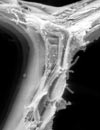Leifsonia xyli: Difference between revisions
No edit summary |
No edit summary |
||
| Line 19: | Line 19: | ||
==Cell structure and metabolism== | ==Cell structure and metabolism== | ||
This genus (formerly Clavibacter), like other Microbacteriaceae, contain unsaturated respiratory menaquinones (MK-10 and MK-11) and an unusual cell wall peptidoglycan with 2,4-diaminobutyric acid (DAB). [http://www.ncbi.nlm.nih.gov/sites/entrez?db=genomeprj&cmd=search&term=leifsonia%20xyli] | |||
==Ecology== | ==Ecology== | ||
Revision as of 23:52, 18 November 2007
Classification
Leifsonia xyli is a Gram negative, aerobic, Rod shaped organism, with arrangment in singles or pairs. It has no Endospores or motility and has a host-associated habitat with opt. temperatures for growth at 20-25 degress celcius with a range in the Mesophilic. It is pathogenic to plants and causes Ratoon stunting disease. [1]
Higher Order Taxa
Taxonomy: root;cellular organism;Bacteria;Actinobacteria;Actinobacteria (class);Actinobacteridae;Actinomycetales;Micrococcineae;Microbacteriaceae;Leifsonia [2]
Species
This species comprises two xylema-associated, fastidious, slow growing subspecies, L. xyli subsp. xyli and L. xyli subsp. cynodontis.[3]
Description and significance
causes ratoon stunting (growth-hindering) disease of sugarcane and Bermudagrass stunting disease, respectively. Ratoon stunting disease is the most economically important disease of sugarcane resulting in 10-15% loss in crop yields worldwide. The disease is difficult to identify and is transmitted mechanically or through infected seeds. Pathogenicity has been associated with production of a toxin. [4]
Genome structure
Cell structure and metabolism
This genus (formerly Clavibacter), like other Microbacteriaceae, contain unsaturated respiratory menaquinones (MK-10 and MK-11) and an unusual cell wall peptidoglycan with 2,4-diaminobutyric acid (DAB). [5]


